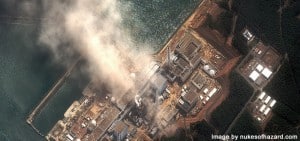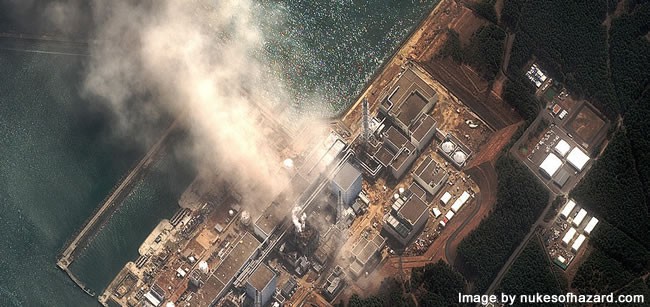The Newman Government’s recent signal to open the door to uranium mining creates grave risks for us all, particularly North Queenslanders, writes Andrew Picone.
Queensland Resources Minister Andrew Cripps recently told AAP that “uranium mining in Queensland has not been the subject of a serious public discussion in Queensland for many years.”
Yet in reality, there been a serious international discussion about uranium and the impacts of the nuclear industry for many decades. In recent times this discussion has been heightened by last year’s nuclear disaster in Japan at Fukushima (pictured), a disaster that was fuelled by Australian uranium.
It was from Australia’s uranium mines that the nuclear tragedy of Fukushima originated. Our uranium was in the Fukushima Daiichi nuclear power complex when hit by a tsunami in March 2011.
The push to convince the LNP Government to overturn the decade long ban on uranium mining in Queensland most often comes from those with a vested financial interest.
The Queensland Resources Council and the Australian Uranium Association tell us that it’s time to develop this State’s uranium resources. Cutting greenhouse gas emissions, economic development and Indigenous engagement is provided as convenient justifications.
However, such justification to create one of the most hazardous industrial wastes just doesn’t stack up. Uranium is not renewable and its radioactivity represents a serious health risk.
It’s hard to imagine the Australian Uranium Association or Queensland Resources Council speaking out about climate change without a vested interest in selling uranium.

If we are serious about cutting greenhouse gas emissions and engaging Indigenous communities in sustainable economic development; we should be looking to the opportunities for solar, wind and thermal energy development across northern Australia.
Indigenous land has some of the best opportunities for the development of these alternative energy industries, a clean and green industry could directly benefit indigenous communities as much as, if not more than, mineral extraction.
Queensland’s uranium deposits are all in the north of the state, from Settlement Creek near the NT border, through Mt Isa and south to Cloncurry, and from Townsville north to Charters Towers and Georgetown.
“Uranium mining consistently generates more hazards, heartache and headlines than benefits. Queensland, especially regional Queensland, is ideally placed to be a world leader in the globe’s fastest growing energy sector – renewable energy,” says Dave Sweeney, Nuclear Free Campaigner for the Australian Conservation Foundation.
Around Australia there are three operational mines; Ranger in Kakadu, Olympic Dam and Beverly in South Australia.
In a recent article, Sweeney describes his recent trip to Japan’s Fukushima region with doctors, academics and radiation health specialists. Over 150,000 people are still displaced in temporary housing shelters because of radiation contaminating their land – radiation flowing from Australian uranium.
As a result of the massive human, social and economic costs now faced by Japan and the growing tide of public sentiment towards the nuclear power industry; Japan has announced plans to switch off all nuclear reactors by 2040. Similar trends have reverberated through parts of Europe.
The other dark side to the uranium industry is its potential military applications.
In December 2011 the Gillard Government announced it would move to sell Australian uranium to India. India is a nuclear armed state and is not a signatory to the Nuclear Non-Proliferation Treaty.
In selling uranium to India, Australia signaled it was willing to do business with nations with an active nuclear weapons program.
Now Pakistan wants to buy our uranium too.
“Adding Australian uranium to the mix would not ease the long standing tensions between India and its nuclear-armed neighbours or improve the effectiveness of the global nuclear safeguards regime,” says Sweeney.
With uranium process heading south in the face of high risks, loss of market and political appetite, it makes no sense to back the introduction of this contested and contaminating industry in North Queensland.
Before the last State election, Campbell Newman made a ‘crystal clear’ statement that there were no plans to change Queensland’s position on uranium mining. It’s time our political leaders kept their commitments and back the renewable energy sector. Uranium is not a safe option for Queensland or Queenslanders.
Andrew Picone is VIce President of the Cairns and Far North Environment Centre and Acting Northern Australia Program Manager for the Australian Conservation Foundation.
This article was published on 21 September 2012 on www.newsport.com.au


